
My grateful thanks to Mr Marijan Dundek of Noble Gems for his kind comments on my website and for giving me his blessing to present
” The Diamond Gallery ”
Natural Fancy Colour Diamonds
In the magical world of precious stones, natural fancy colour diamonds hold a place of their own. They are a miracle of nature, revealing themselves in incredibly beautiful shades, hues and colours such as yellow, green, blue, purple, pink, orange and – extremely rarely – red. Over 300 colours have been
identified so far.
For every 10,000 colourless diamonds, only one natural colour diamond will have made the trip from the depths of the earth to its surface. They acquire their colour from special conditions during their formation, such as the presence of trace elements, distortions to the diamond crystal due to pressure, or exposure to radiation.
We usually think of diamonds as colourless, and try to get the clearest and most pure diamond we can. Diamond colour after all usually means the lack of colour. Well, that is true for the majority of diamonds, but occasionally diamonds do form into coloured gemstones. There are pink diamonds, blue diamonds, green diamonds and more– all formed naturally. These are called Fancy Coloured Diamonds and they are extremely rare and expensive. We stress ‘Natural’ because colour enhanced Diamonds are easily available and nowhere near as valuable.
You will not find natural fancy coloured diamonds in most jewellery shops. There are waiting lists years long just to have the opportunity to purchase certain coloured diamonds. Out of around 80,000 carats of rough diamonds that are mined every year, only 0.001% are fancy coloured diamonds. The intensity of color is unique in each colored diamond. Unlike colourless diamonds, where more valuable diamonds have less colour, with fancy coloured diamonds the more vivid the colour the more valuable the diamond.
The beautiful colours present in the diamonds happen during the formation of the diamonds or as it rises to the surface of the Earth. The exact circumstances that form coloured diamonds are so uncommon that coloured diamonds seem like a statistical impossibility. Yet they exist and fill us with wonder. Some clear diamonds are enhanced in order to create the desired colour, but these do not match the diamonds that come by their fancy colour naturally.
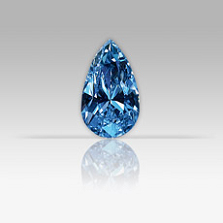
Natural Fancy Blue Diamonds
Natural fancy blue diamonds are truly noble gems. Extremely rare, these fascinating stones are synonymous with great honour and spiritual tranquillity, and throughout history have been associated with royalty. Blue diamonds are classified as either blue, greyish blue, greenish blue, turquoise or aquamarine.
The colour of blue diamonds is caused by the presence of boron atoms; the higher the concentration of boron, the more intense the colour.
Some exceptional and very rare turquoise and aquamarine coloured diamonds with an extremely brilliant appearance have been found to be coloured because of their long exposure to natural radiation; examples of these have been found in Guyana. And in Argyle blues, which are usually grey blue, the colour is related to the presence of hydrogen and also, sometimes but more rarely, to that of nitrogen.
The Cullinan and Premier mines near Pretoria, South Africa are the world’s only notable blue diamond producing mines. A small number of extraordinarily deep blue diamonds have also been found in Central Africa, Brazil and Borneo. In the past, some of the most historically famous blue diamonds were sourced from India. The Argyle mine in Australia extracts metallic blue diamonds. Further reading
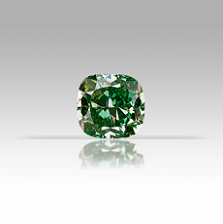
Natural Fancy Green Diamonds
Natural fancy green diamonds are extremely rare, especially those with no other secondary hues or modifiers. Most green diamonds have either grey, brown, blue, orange or yellow modifiers.
The green colour is caused by millions of years of exposure to naturally occurring radiation. Very rarely, hydrogen may be the cause in some greyish green stones.
Green diamonds come chiefly from south-central Africa, Brazil, British Guyana and Borneo.
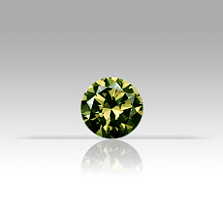
Natural Fancy Olive Green Diamonds
Often confused with the green family, olive occupies a distinct and separate colour space next to green. Bordered in this space by grey, black, brown, yellow and green, pure olive stones often have one or more of these modifiers to impart true uniqueness to their hue. Modifiers include grey, green, black, brown and yellow.
The olive green colour is caused by the presence of hydrogen impurities interacting with the stone during its formation.
Beautiful olive diamonds come from Brazil as well as from central Africa, the Democratic Republic of Congo and South Africa.
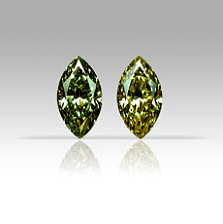
Natural Fancy Chameleon Diamonds
The chameleon diamond is a very rare gemstone with the incredible ability to temporarily change colour from greyish yellowish green to brownish or orangey yellow when kept in the dark or when gently heated.
This fascinating characteristic of being able to change colour is due to moderate to high amounts of hydrogen in the diamond’s structure, in addition to some isolated nitrogen and traces of nickel.
Chameleon diamonds are sourced from southeast Asia, mainly China, central Africa, Australia and Brazil.
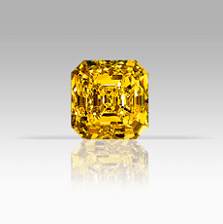
Natural Fancy Yellow Diamonds
Natural yellow diamonds are the most familiar of all coloured diamonds. Because of their pleasing yellow colour, these stones are frequently associated with sunlight, cheerfulness, joy, prosperity and happiness.
The yellow colour is due to the presence of nitrogen in the structure of the crystal.
These gems are sourced mainly from South Africa, as well as small numbers from other African countries, Brazil, Russia, Australia and India.
The 118.08 carat Delaire Sunrise is the largest Fancy Vivid yellow, square emerald cut diamond in the world.
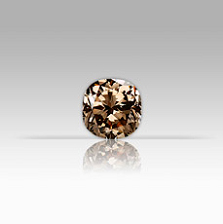
Natural Fancy Brown, Champagne Diamonds
Natural fancy brown coloured diamonds are sometimes referred to as champagne, lightly tinted brown, cognac or chocolate, depending on their tone (darkness). They generally show a hint of greenish, yellowish, orangey or reddish modifying colours.
The brown colour is caused by internal parallel grain lines. If the brown grain lines exist in a diamond that is also coloured yellow by nitrogen impurities, they produce a yellowish brown colour.
The Argyle diamond mine in western Australia is the world’s largest producer of these stones. Shades ranging from champagne to cognac are found in Australia, Brazil, Borneo, the African continent and Russia.
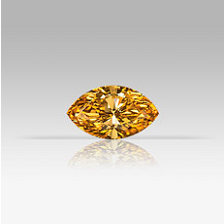
Natural Fancy Orange Diamonds
Prized for their beauty and rarity, orange diamonds are among the most sought after colours. More common, yet still rare, are orange diamonds with a natural colour modifier such as brown, yellow, pink or red.
The orange colour is thought to be due to a combination of structural deformities and the presence of nitrogen in the pure carbon structure; however this has not been verified.
Orange diamonds are predominantly sourced from South Africa, the Democratic Republic of Congo and Russia.
Further reading
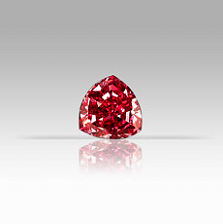
Natural Fancy Red Diamonds
Red diamonds are the rarest of coloured diamonds. Only a handful of them have ever received the grade of fancy red, a red diamond in its purest form.
The red colour is caused by a distortion of the atomic lattice, or graining (a process known as ‘plastic deformation’). There are brownish red, pinkish red, and purplish red diamonds, but these stones are generally rare and their prices reflect their scarcity on the market.
Red diamonds tend to be found in small sizes in Australia, Brazil and Africa. The world’s largest known red diamond is the magnificent, internally flawless 5.11 carat Moussaieff Red, discovered in Braz
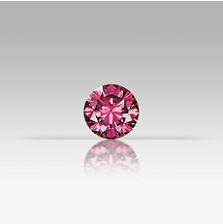
Natural Fancy Pink Diamonds
Pink is one of the rarest and most desirable colours, often sought for its romantic associations. A pure pink colour with no trace of secondary modifying colours is exceptionally rare and valuable, and usually found in small-sized stones.
The pink colour is caused by a distortion of the atomic lattice, or graining (a process known as ‘plastic deformation’).
Today, over 90% of the world’s pink diamonds come from the Argyle mine in western Australia, including its hugely coveted full-bodied ‘hot pinks’. Other sources are India, Borneo, China, Brazil, Guinea, Angola, South Africa and Tanzania.
Further reading
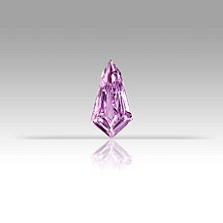
Natural Fancy Purple Diamonds
Pure purple colour diamonds are almost non-existent, since purple is made of pink and blue. One will more often see purple diamonds described as pinkish purple. Often confused with the secondary colour violet, purple is a dominant and rare hue in natural colour diamonds. These diamonds tend to have grey or pinkish modifiers.
The purple colour is caused by deformation of the diamond’s atomic matrix.
Purple diamonds are most often sourced from Russia, Brazil and The Argyle Mine in Australia.
Further reading
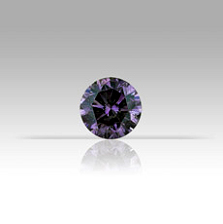
Natural Fancy Violet Diamonds
Natural pure violet diamonds are extremely rare and belong to the purple diamond family. Pure violet with no secondary hue is almost non-existent and such gems will appear only in small sizes. Violet usually appears with grey or blue as a secondary hue; such stones can therefore be violet, fancy bluish violet or fancy greyish violet.
The violet colour is caused by the presence of hydrogen, which produces unique violet hues. They are found in a combination of blue diamonds and purple diamonds, and come in different hues and intensity.
Violet diamonds are sourced from the Argyle mine in Australia as well as from Russia.
Further reading
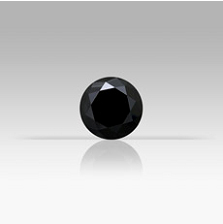
Natural Fancy Black Diamonds
Natural black diamonds look striking and dramatic. They are not transparent and do not show ‘fire’ (flashes of colour), but can be exceptionally impressive. Black diamonds may show white or grey inclusions that make them very unique.
The black colour is caused by a myriad of graphite inclusions, and some stones have been found to contain trace elements of nitrogen and hydrogen. It is believed that some of the black diamonds fell to the earth as meteorites.
Black diamonds are sourced from Brazil, South Africa, the Central African Republic and Borneo.
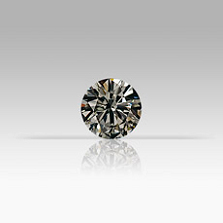
Natural Fancy Grey Diamonds
A combination of black and white, grey is a non-spectral colour. In their purest form, grey colour diamonds come quite close to colourless stones, however they are a highly prized rarity and offer a remarkable range of modifying colour combinations in grey, bluish grey and greenish grey.
The grey colour is caused by the presence of hydrogen and little or no nitrogen, while bluish grey is generally thought to be caused by boron.
Grey diamonds come from Australia, South Africa, the Democratic Republic of Congo, Russia, India and Brazil.
Further reading
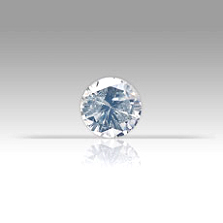
Natural Fancy White Diamonds
True white diamonds should not be confused with colourless diamonds as there is an inherent snow-white colour to this gemstone. White diamonds differ from colourless in that they are not clear. Pure whites with no secondary colours are rare and highly desirable to dealers and collectors. White diamonds can have a brownish, bluish, yellowish or greyish appearance.
The white colour may be due to nitrogen and a high concentration of submicroscopic inclusions that scatter light, yielding a translucent ‘milky’ white colour. The precise nature of these inclusions is unknown. White diamonds are sometimes called ‘opalescent’ because the dispersion of the light looks somewhat similar to that of opals.
Fancy white diamonds are sourced from the Democratic Republic of Congo, Zimbabwe and central Africa.
Natural Fancy Coloured Diamonds: Sources and Causes of Colour |
||
| Diamond Colour | Sources | Causes of Diamond Colour |
| Red Diamond | Australia, Brazil, South Africa | Irregularities in the crystal’s atomic structure as a result of deformation |
| Violet Diamond | South Africa, Australia | Hydrogen impurities |
| Purple Diamond | Russia (main source), South Africa, Democratic Rep. of Congo | Irregularities in the crystal’s atomic structure as a result of deformation |
| Green Diamond | Borneo, Brazil, Central African Republic, South Africa | Natural radiation; hydrogen, green fluorescence may occasionally make a diamond appear greenish |
| Blue Diamond | South Africa (main source), Borneo, Brazil, Central African Republic, India (historic) | Boron impurities, sometimes radiation |
| Orange Diamond | Democratic Republic of Congo, Botswana, South Africa | Probably chemical impurities and structural distortion |
| Pink Diamond | Australia (main source), Angola, Borneo, China, South Africa, Tanzania, India (historic) | Structural defects combined with various impurities of nitrogen or hydrogen |
| Yellow Diamond | Angola, Borneo, Brazil, Central African Republic, Guinea, Ivory Coast, Russia, Sierra Leone, South Africa, Venezuela | Isolated nitrogen atoms that randomly take the place of individual carbon atoms or aggregates (clusters) of 3 nitrogen atoms |
| Green-Yellow Diamond | Brazil, Ivory Coast, Venezuela | Natural radiation, hydrogen, nitrogen |
| Olive Diamond* | Central African Republic, Sierra Leone, Borneo, Russia | Natural radiation, hydrogen, nitrogen |
| Black Diamond | Central African Republic, South Africa | Black inclusions |
| Brown Diamond | Australia, Angola, Borneo, Brazil, Democratic Republic of Congo, Ivory Coast, Russia, Venezuela, South Africa | A defect in the atomic structure of the crystal probably caused by tremendous pressure and evidenced by coloured graining |
| Gray Diamond | Central Africa, Congo | Hydrogen impurities |
| Chameleon Diamond** | Central Africa | Natural radiation, hydrogen and nickel impurities. Cause of colour change not certain. Nitrogen, nickel and/or hydrogen may be involved |

